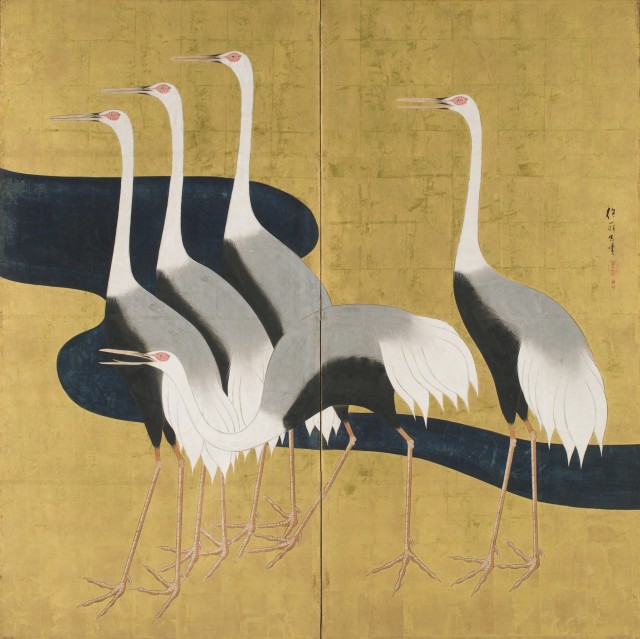
Sakai Hōitsu, “Cranes,” two-panel folding screen, ink and colors on paper, circa 1820 (courtesy the Nelson-Atkins Museum of Art, Kansas City, Missouri)
Japan Society
333 East 47th St. at First Ave.
Tuesday – Sunday through January 6, $15 (free Friday from 6:00 to 9:00)
212-715-1258
www.japansociety.org
Born in Edo to an aristocratic samurai family and trained in Kyoto, Sakai Hōitsu became a master artist specializing in gorgeous depictions of nature, particularly birds, plants, waves, and flowers, often painted on gold-leaf backgrounds. Dozens of his dramatic works are on view in the sumptuous “Silver Wind: The Arts of Sakai Hōitsu (1761–1828),” continuing at Japan Society through January 6. This first major American retrospective of Hōitsu, who was also a poet and became a Buddhist monk in 1797, follows his development as a student of the Rimpa school, copying and/or inspired by works by brothers Ogata Kōrin and Ogata Kenzan, and concludes with paintings by Hōitsu’s own pupil, the supremely talented Suzuki Kiitsu. In the two-panel folding screen “Cranes,” Hōitsu portrays five cranes on a gold landscape cut in half horizontally by a winding black river; the detail in the birds’ eyes and feet is dazzling. “Spring and Autumn,” a pair of two-panel screens, and “Maples and Cherry Trees,” two six-panel screens, come alive with spectacular colors so vibrant you can practically smell the grass and flowers spread across them. “Views of Xiao and Xiang” is much subtler, a peaceful purple-gray scene with emptiness leading to the titular Chinese mountains in the background. In the hanging scroll “The Poet Hitamaro,” Kakinomoto no Hitomaro, one of the Thirty-Six Immortal Poets, is shown sitting cross-legged on the right, gently smiling at a forest on the left. The last room dedicated to Hōitsu is the stunning “Birds and Flowers of the Twelve Months,” as he lyrically depicts the changing seasons with grace and beauty, featuring such birds as the white camellia, the Siberian blue robin, the warbler, and the sparrow. The exhibition ends with the work of his primary disciple, Kiitsu, whose lush style predicts the popularity of Japanese manga as a method of visual storytelling. “Silver Wind” is a breathtaking exhibition that holds that much more power as the year finishes up with dreary gray days filled with dank cold and rain.